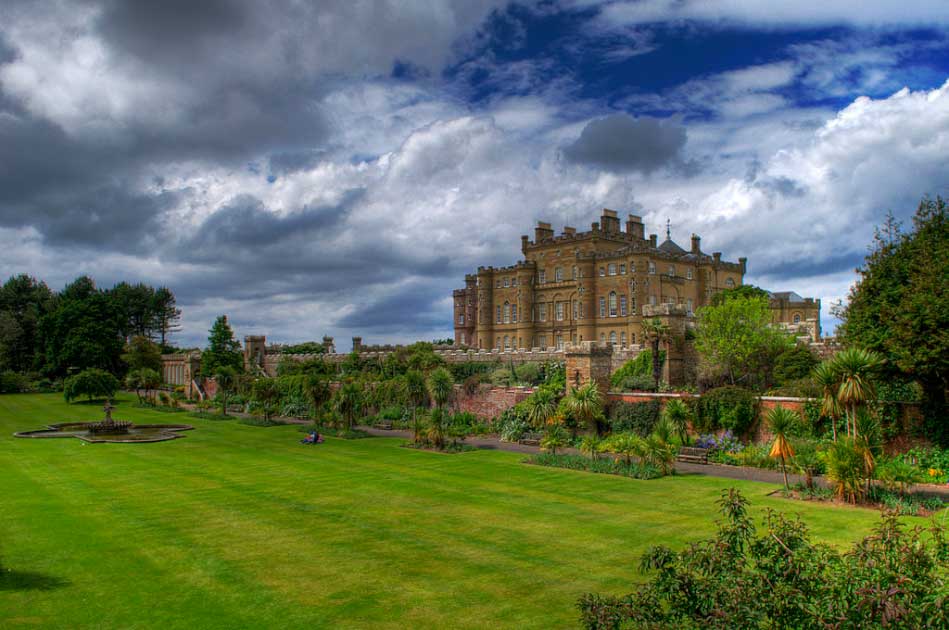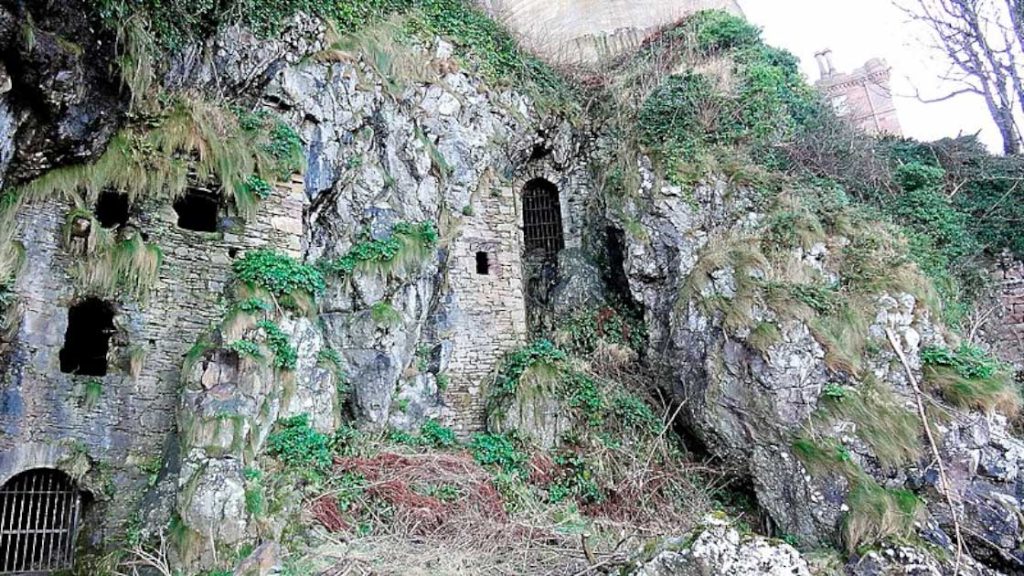On Scotland’s rugged south west coast, where the Atlantic seas strike hard against the rocky, windswept shores, lies a neoclassical masterpiece. Culzean Castle, seat of the Scottish clan Kennedy and former home to their chief, the Marquess of Ailsa, dominates the landscape with its round towers, high walls and fortified exterior.
The castle itself is more or a romantic fantasy than a real defensive fort however. Built in the late 18th century as a grand country house for the Earls of Cassilis, and laid down by the 10th Earl in 1777, it marries grand living and luxury with deep Scottish roots. Constructed in the L-shape fashion common for Scottish castles, she may seem to be a luxury house but she had defensive qualities hidden beneath the surface.
In fact, Culzean Castle is full of secrets, and much is not what it seems here. This cliff-top castle with its sea views and richly appointed interiors masked a greater secret than most suspected. For deep in the lowest levels of the great castle can be found a hidden, secret doorway, which opens onto steps leading down into the darkness.
Under Culzean castle is a vast cave complex, leading right down to the sea. And here, it was rumored, the Earls of Culzean may have hidden a dark secret. What were they using the hidden caves for, and what was the secret of Culzean Castle?
Stately Culzean Castle
The Culzean Castle is popular with visitors today for its painted ceilings, elegant oval staircases, delicate friezes, and its grand circular saloon in its round tower. It is also a storied castle with some dark skeletons in its closet, such as a walled garden built on the home site of a former slave of the Kennedy family.
And of course the current castle is not the first on this site. Undiscovered Scotland, a Scottish tourism organization, estimates that the origin of the Culzean Castle can be traced back to a stone tower that was erected in the late 14th century.
The castle was initially known as Coif Castle or the House of Cove, named for the sea access the caves provided underneath the castle. We know that in 1569, the castle was gifted by the 4th Earl of Cassilis, Gilbert Kennedy, to Thomas Kennedy, his brother, demonstrating that the castle had been in the clan for many hundreds of years. After a period in the 17th century where it was named Cullen Castle, this was changed to the more properly Scottish Culzean Castle.

David Kennedy, the 10th Earl of Cassilis and 5th Baronet Kennedy, started the ambitious remodeling campaign in 1775 when he inherited. He ordered the construction of the modern Culzean Castle. Designed by Robert Adam the castle took 15 years to build, and was constructed from 1777 to 1792.
- Singer Castle on Dark Island: Hidden Secrets of a True American Castle
- The Beast of Glamis Castle: A 200 Year Old Royal Monster?
Sadly David Kennedy was the last Baronet Kennedy, and the title was lost when he died without issue. The earldom of Cassilis was passed to his distant cousin in New York and raised to a Marquisate in his nephew’s time. The Kennedy title may have gone but the Kennedy clan endured, and they kept their castle too.
The Kennedy family only finally handed over the castle for preservation by the National Trust for Scotland in the year 1945. However, they demanded that the apartment present at the castle’s top would be given to Dwight D. Eisenhower, then the overall commander of the victorious WW2 Allied army.
It was given to him in recognition of his contribution to the Second World War as the Supreme Commander of the Allied Forces. In the year 1946, the castle was first visited by the General. In totality, the General stayed in the castle four times.
The Caves of Culzean Castle
So much for the history of the castle, but what of the secret caves hidden beneath it? When it comes to the use of those caves, there exist a number of stories relating to them. Many believe that the caves are haunted, and at least seven ghosts are said to live there.
But the caves had a practical use, as well. Evidence shows that the staff members of the castle used the caves to receive, sort, and store sundries and supplies from the ships arriving at the beach far below. This may just have been a cover story however, and many believe that the castle caves were actually used for something far more illegal: smuggling.
During the 18th century, the network of tunnels seems to have become a center for smuggling. Smuggling was widespread in that region at that time. The castle was located in close proximity to the Isle of Man.
On the Isle of Man, customs taxes were very less. This made the caves of the Culzean Castle an ideal destination to store highly taxed goods like tea, tobacco, and brandy. The secluded location of the caves allowed the smugglers to start their unsavory ventures. They used the tunnels to hide contraband, from tobacco to alcohol and even silks.
It would be very surprising if smuggling could happen in the castle without the knowledge of the Kennedy family. Could the earls therefore be complicit in the illegal activities going on beneath their feet? Was the location of Culzean in fact preferred for this very reason, and was the castle itself only a front?
- Nonsuch Palace: What Happened to Henry VIII’s Lost Castle?
- Kinbane Castle and the MacDonnell Clan of Antrim
Apart from these theories, one of the more prosaic and believable uses of the tunnels underneath the castle is its use as a cellar for storage. It is said that the tunnels were used as cellars before the conversion of the castle into the grand country house that exists today. Various provisions were stored in the tunnels, including wine.
The Hidden Doorway
Ot also seems that Culzean Castle still has some secrets to give up. Recently, a team of archaeologists volunteered to investigate the castle’s tunnels. What they found was surprising and unexpected.

The researchers found a hidden doorway that is believed to have been built hundreds of years ago. The main purpose of the doorway was to control access to the cave entrance. The medieval-era doorway provided passage from the Ayrshire cliffs to the Culzean caves.
The volunteers who worked with NTS or National Trust for Scotland found the hidden door while digging. The NTS head of archaeological services, Derek Alexander, mentioned that the researchers had previously identified a doorway and wall at the mouth of the underground tunnel. However, they did not know that a similar entranceway to another cave complex known as Stables Cave also existed.
The doorway measures about 3.5 feet (1 m) across and is present at a depth of nearly 3 feet (0.9 m). Stones found in the entranceway are indicative of the fact that the door was made into a wall. It was secured with a bar.
The discovery of the doorway provides a better picture of the function and structure of the caves. The doorway could have guarded and locked the caves underneath the Culzean Castle. Other artefacts that were found during the investigation include broken pieces of glass, modern pottery, and wine bottles.
The radiocarbon dating test of a charcoal sample showed that it dated back to 135 and 325 A.D. It reveals that the cave under the Culzean Castle was occupied by people during the Iron Age. Whatever was going on in those caves, it predates both the latter day smuggling and the taxes that necessitated such illegal activities.
It is very unlikely that everything is known about the secret caves, and Culzean Castle doubtless still has secrets hidden in the dark tunnels. Happily the castle is now open to the public: maybe some unsuspecting visitor will stumble on something else unexpected in the underground labyrinth beneath the great house.
Top Image: Culzean Castle with the hidden caves apparent in the cliffs below. Source: Stuart / Adobe Stock.
By Bipin Dimri